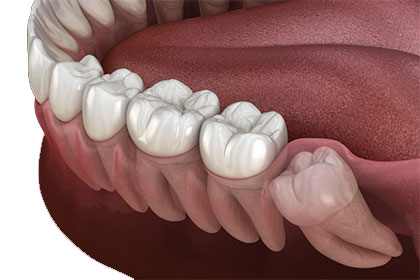What are Wisdom Teeth?
Wisdom teeth are the third set of molars. They are located in the back of your mouth and typically begin to come in between the ages of 17 and 25. A dentist may notice them in an X-ray, or you may experience pain as they come in – prompting a visit to the dentist.
Depending on how your wisdom teeth come in, the development of these molars can be quite painful. The removal of these teeth depends on specific factors. A dentist will need to examine your teeth to determine if removal is the best procedure.

Why Do Wisdom Teeth Need to Be Removed?
Wisdom teeth do not always need to be removed. Though, it is very common. Here’s a look at the most common reasons for removing these teeth:
- The teeth are impacted – they are located far back in the mouth, which can lead to severe pain.
- Your mouth is not big enough – the teeth take up too much space along your jaw.
- The teeth came in at a weird angle – if the teeth grow in at the wrong angle, they may press against other teeth. This can lead to misaligned teeth and additional pain.
Another reason is that the wisdom teeth have cavities or signs of gum disease. Even if your wisdom teeth grow properly, they are located far back in the mouth. This makes them difficult to reach with a toothbrush and floss.
Wisdom teeth are more likely to decay or suffer from various dental issues. This could then require the removal of the teeth to prevent further damage.

What are the Signs That You Need Wisdom Teeth Removal?
If you have been experiencing pain along the back set of teeth, then you should make an appointment with your dentist. The pain could be the result of an issue related to your wisdom teeth. A full examination will be needed to determine the cause of the pain.
When you ignore the symptoms of any illness, medical condition, or dental issue, the problem can become more severe. For example, if you ignore the damage caused by your wisdom teeth, you could end up with misaligned teeth or damage to adjacent teeth. You also increase the risk of complication during surgery. Or, the procedure may require additional steps, which will lead to higher costs for the operation. Some people end up with cysts or tumors, which can be painful and expensive to remove.
Along with general pain, you may experience other symptoms related to wisdom teeth issues. Pay attention to all of these signs. If you notice several of these, it’s important to schedule an appointment as soon as possible:
- Tenderness
- Jaw pain
- Redness of the gums
- Swelling of the gum
- Bad breath
- A bad taste in your mouth
- The presence of cysts (pockets of liquid around your gums)
If your wisdom teeth are not the cause of these symptoms, it is still vital that you make an appointment with your dentist. There has to be a cause for your pain, which will require examination and treatment.
Here some things that you should do and some things that you should avoid:
- East soft foods
- Drink plenty of fluids
- Use an ice pack to help with swelling
- Use moist heat to help with a sore jaw
- Do not brush until the second day
- Take any medications prescribed for the pain and swelling
- Do not drink through a straw
- Do not eat hard or crunchy food
- Do not eat sticky food
- Do not smoke
If you follow these recommendations, along with any suggestions from your dentist, you can expect the majority of the pain, swelling, and discomfort to subside within a few days to one week.Any pain around the sockets and the healing of stitches can take up to 4 weeks to fully heal. But, after the first week, you begin to loosen the eating restrictions. Though, you should still be careful while chewing food near the site of the operation.

